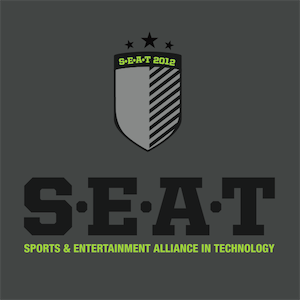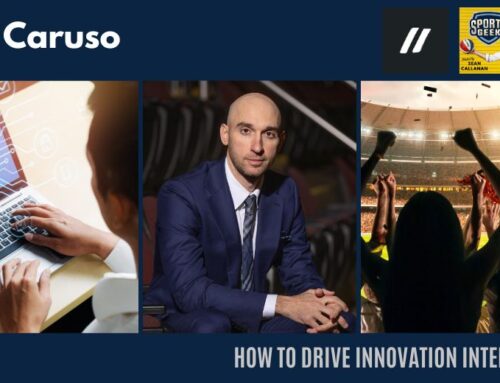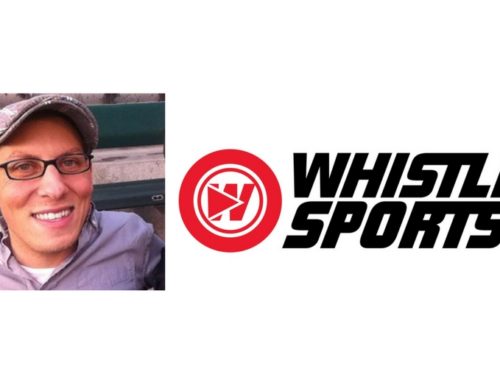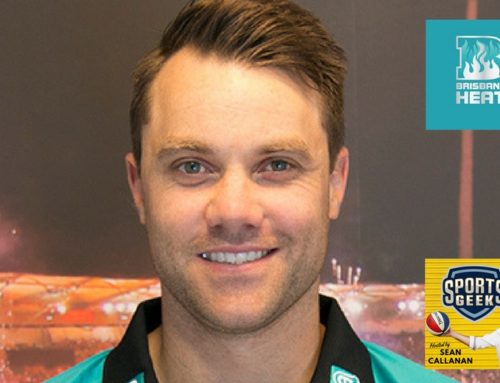This week on ABC Grandstand, Sports Geek again discussed the problem of mobile access at sports stadiums, we were lucky to be joined by Chris Dill from SEAT. At the SEAT Conference there will be sports technology executives discussing this very problem.
Stadium & Mobiles
 Many times at sporting events you might want to share a picture on Instagram or check in on Foursquare or perhaps brag about the game on Facebook or Twitter but you are unable to due to lack of access.
Many times at sporting events you might want to share a picture on Instagram or check in on Foursquare or perhaps brag about the game on Facebook or Twitter but you are unable to due to lack of access.
Stadiums provide the “perfect storm” for poor mobile access – large structure with concrete & steel combined with large crowds with bandwidth hungry devices.
Be sure to follow SEAT Conference on Twitter as the conference kicks off August 5 in Boston.
Chris will keep you up to date with behind the scenes conference news.
Until next week
Catch it live on Saturday mornings (at 7:40am) when Sean Callanan discuss sports digital with Francis Leach on ABC Grandstand. Tune into ABC Grandstand Breakfast Friday through Monday on ABC Grandstand digital radio.
Want to get these clips in podcast form? Subscribe here or Add to iTunes.
Podcast transcription
FRANCIS: Francis Leach here on this Saturday morning, good morning to you, hope you’re well. Each Saturday we catch up with Sean Callanan, the Sports Geek, to talk about sport and the digital space, and he’s here again this week. Good day Sean how are you?
SEAN: Good day Frank, I’m very good.
FRANCIS: Now I’ve been missing something, everyone’s been watching the Tour de France, everyone’s been trying to get Cadell up the mountains and down the other side, but the real battle is not out there on the road, it’s in fact in the Twittersphere between the WAGS.
SEAN: Yes.
FRANCIS: What am I missing?
SEAN: Yeah hash tag #wagwar. Now a few of the WAGS have been chipping in with a bit of the commentary that the fans are having and even a few of the boys, the riders, have had a bit to say and yeah it’s provided a little bit of back channel entertainment for those following the Tour de France.
FRANCIS: Are they hash tagging themselves #wagwar?
SEAN: No. No. But their fans have, and if – I actually did tweet it, like it got covered in the New York Times where they were bringing all the tweets of all the – all the riders.
FRANCIS: What have been the subjects that have been carried during the WAG wars is it – is it just about my man’s better than your man on the hills.
SEAN: Oh there’s a little bit of that, there’s a bit of you know “he’s not following the team rules”, and a bit of that happening and then they got into a little bit of accusations of whether it was a clean race and “I know more than you” and that kind of stuff.
FRANCIS: All being played out in public on Twitter.
SEAN: All being played out in public, so yeah it is a dangerous space for the WAGS to be on Twitter.
FRANCIS: Brilliant for everyone else though.
SEAN: Yeah it’s brilliant for everyone, it’s a bit like the old rubber necking, like seeing a car crash and people you know watching it go by, so.
FRANCIS: Now are there particular people we should search for and try and follow to pick up some great WAG war action?
SEAN: Oh yeah I think if you just follow the TDF, there’s enough fans re-tweeting, but yeah a lot of the wives of the current leaders are chipping in on Twitter. So yeah it provides a little bit more entertainment if you’re just watching all the beautiful scenery going through France, but yeah seeing some um, very fired up ladies watching the cycling.
FRANCIS: Looking forward to getting into a bit of that and reading a few time lines to see what’s being said. Now at the moment we’ve been talking about the last sort of six months or so a whole range of issues when it comes to digital space and sport. One of the issues we’ve talked about a lot is the fact that when we go here in Australia to sporting venues for instance, you can’t actually engage with the game the way you might like to if you’re on your couch at home, because you’ve got WiFi, and you can use all the Apps and devices and what not to be socially interactive – – –
SEAN: Yep.
FRANCIS: – – -in the sport. The MCG or the SCG that just isn’t possible, critical mass means that you can’t. Are we getting any better at it?
SEAN: We are slightly better at it, but one of the things is, is as successful as you might become in getting the infrastructure in place, the fans will then chew up their band width, and actually it will crash, so – – –
FRANCIS: Can’t help ourselves, is that what you’re saying?
SEAN: – – – exactly. So the more success that the technologists have in – in getting the infrastructure right, the more that the fans want to use it. So the Major League Baseball All Star game is a good example at Kansas City. They really did a – made a big effort from a social media point of view to really engage the fans in the stadium, promoting hash tags for a Twitter point of view, they had the player handles, being referred to on the coverage and everything – – –
FRANCIS: It was great.
SEAN: – – – and the thing was what they found, you know they got great lift from people around and watching the game, but they really pushed the limits in the stadium, so you know great success – the fans loved it – but there was some frustration that you know people couldn’t get their – couldn’t get their tweet out the door.
FRANCIS: Now one person that knows a lot about this is joining us now, Chris Dill, who’s the CIO at the Portland Trail Blazers.
SEAN: Well he’s formerly of the Portland Trail Blazers, now he’s Business Development at SEAT Conference, which will be in Boston in August.
FRANCIS: Now what’s SEAT Conference?
SEAN: SEAT is Sports Entertainment Alliance and Technology. So very much in the same wheelhouse as they might say as Sports Geek, but talking to all the IT guys that are trying to solve this problem in venues, and for teams. So very much knows all the guys who are going to fix this problem for us.
FRANCIS: Good day Chris, welcome to Grandstand Breakfast, how are you?
CHRIS: Oh thank you for having me, I’m so excited, I’ve been listening for the last half hour, I’m totally sold, I get to hear a Sly and the Family Stone, you’re talking about the Tour de France, I wish I was over there now, I’m a big bike rider and I was talking to my business partner, I said you know for our conference next summer it’s going to have to be buttoned up by now, because I’m going to be in France, next year for the Tour.
FRANCIS: Probably if you’re in France and in regional France and you want to engage digitally with the sport, I wonder how you’d go, what would be the band width capacity like in Europe to be able to do that, you know on a moving feast like the Tour.
CHRIS: Well you know what, no matter where you go these days you expect to be connected. Because look at – look at the proliferation of the iPads and the phones and the Smartphones, where can we go without them. You know the Achilles heel on those kind of devices is the battery and how is that, but as long as you’ve got juice wherever you’re sitting you want band width. So it isn’t just about going to sporting events, you could talk about stadiums, you could talk about hospitals, you could talk about the NIKE Campus or you could talk about college campuses, so we’re going to talk in particular about sports spaces, but when it comes to WiFi and DAS it’s almost no matter where you’re sitting because if you went to one of the local coffee shops there and you didn’t get connectivity you would probably go over to the next shop. So we sort of expect this kind of connectivity whether we’re at the Tour de France, or we’re in watching an All Star game or maybe we’re at the Opera House in Sydney. I mean we’re all always on, we’re all always connected, so we’re sort of creating this infrastructure problem that as we move from sending emails and twittering and texting to watching video highlights from sporting events, which we all love to see, I mean I love to watch the Tour highlights, it’s fantastic, but you know as we go and do this on our devices it becomes a real challenge to the infrastructure out there.
FRANCIS: Chris one thing we are seeing, we’re seeing the prevalence of in stadium Apps in some of the stadiums in America, you can now – you can order your beer and chips or your concessions as they say in the States straight from a – straight from an iPad app or from your phone, unfortunately we did see some poor bloke updating his Facebook status at the baseball and got clocked by a foul ball, so sometimes it is – is important to pay attention to the game and not always to be looking at your Smartphone, but what are – what are things that the stadiums are now doing to try to – to try to solve the problem, and what kind of stadiums are doing a really good job at that?
CHRIS: Well I think that the challenge is that one day you put in the technology and then there’s new technology and then you’re sort of out of date. So the Cowboys stadium, billion dollar stadium, here it is a couple of years later, and the system that they have in there isn’t adequate now. So you come up with technology always at what is sort of the refresh rate and how long is your laptop good for, how long is your cell phone good for, it’s the same thing about the infrastructure that you’re connecting too and how much band width is offered. And people are doing a good job, and probably the ones that have the newest buildings because they have the latest technology on there – in there but you know when we go up to the SEAT Conference in Boston this summer, Fenway Park is celebrating its hundredth anniversary, so here is a case where – here’s a little park and there’s probably been discussions over the years of hey let’s replace this park, and they haven’t.
FRANCIS: No. No Chris.
CHRIS: They certainly have changed their infrastructure.
FRANCIS: I will cry, I will cry myself to sleep for weeks if they – they touched – touched a lick of paint on that place.
CHRIS: Yeah hundred years old so we’re excited, we’re going to have an event up there, but they have new DAS and WiFi in there, but every year they have to improve that. If you look at the San Francisco Giants, when it comes to baseball there seems to be more usage of iPads and you know there’s a lot of breaks in the action versus if you look at soccer, you know there aren’t so many breaks so you have a little less usage, so it really depends on the game and how many breaks there are. People in the American Football world, there’s quite a few breaks and people want to sort of see the Red Zone and what’s going on and we’re seeing in football in all the leagues, so many people are involved in fantasy games that these in venue buildings need to deliver up all these kind of stats and replays. So if you talk about wanting to see replays now you’re really talking about band width usage. And so this becomes a bigger problem. What’s happened in the past number of years is that something like the Super Bowl when you have these incredible half time acts or just people being at the Super Bowl, there’s actually people taking pictures and doing videos and sending them out of the arena, so there’s actually more data going out of the arena than in, and typically networks are built to be inverts of that. We expect to download more data than out load data, so this is a challenge for the people running these types of events.
FRANCIS: The other challenge Chris is you put in this infrastructure, who pays for it? Does it become something that has to get passed on to the fans? Is it something that sponsors and advertisers can bring; or is it just something that – that teams just have to wear because it’s starting to become a service expectation?
CHRIS: I think there’s an expectation but I think there’s a real challenge and we have a great panel at SEAT this year, the DAS panel and we have a representative from AT&T and some of the other DAS vendors and I recently met with Chad Townes, who’s really at the top of the pyramid in the US for AT&T over DAS and WiFi, and his challenge is that the stadiums want him to keep his AT&T equipment up to date and provide full connectivity, they want him to do it on his dime, they also want him to potentially buy a sponsorship and they also want to rent him space in the arena to put his equipment. So he’s going wow this is a tough proposition especially since I’m going to have to replace the equipment every couple of years, and you’re talking about a couple of a million dollars. Now I talked to him about the Super Dome down in New Orleans, and they said that they sank probably $60 million into that facility because they were going to have the Super Bowl, they had the MCAA finals, and some other big events and they had great coverage for that, but look at what cost. So it’s incredibly expensive to provide that band width.
FRANCIS: And in terms of the cost of the fans accessing will it become a user pay service? I mean will you get to a stage Chris Dill where fans who want to access really fast connectivity within stadiums will pay a price to do so? At point of sale, so you sit there in your seat and it goes do you want band width, yes I do, pay five dollars.
CHRIS: The technology isn’t there and I don’t know if we’ll get there because remember in the – in the good old days here in the US Starbucks had the pay for WiFi model and now it’s all free. And so we’ve almost come to expect, just like we’re breathing the air and just like you can get free TV in places and you get free radio, I think the WiFi and the band width and the DAS become a part of life that we expect, and people will try to figure out money on how to actually put ads, interject ads in there and do some controls in those ways to make some money back. But I don’t see where the pay model, now certainly at home you know I use my cell phone as my home phone, I have a nice high speed internet connection because I like to watch my Net Flicks so here I am instead of watching TV that would come in on a coaxial system I’m watching on demand TV, the highlights on my laptop or Net Flicks on my TV. So this – even at the homes there’s a challenge to get enough band width, because who wants to be watching a nice high definition movie and all of a sudden you know it says buffering, this is very annoying to us and we just expect to have this unlimited band width, so it’s really a challenge for the technology companies and it will be a continuing challenge and I think probably the hottest topics at the conference this year, but I foresee it being the hottest topic for the next so many years and may be every year into the future because it will always be a challenge.
FRANCIS: Good on you Chris great to get your insights, thanks for talking to us and good luck with the SEAT Conference in beautiful Boston this year.
CHRIS: Thank you very much for having me, I really appreciate it. I have been down to Sydney in the past and I love your country and you know just a great country and I hope to get back some day and thanks for having me.
FRANCIS: Thanks Chris. Chris Dill there, he’s running the SEAT Conference, remind us what that is.
SEAN: So yeah it – sports tech and digital and CRM guys who are all going to get into one space and try to solve some of these problems in Boston in August 5 to 8.
FRANCIS: Geeks – geeks with mouthguards.
SEAN: Yes, pretty much – pretty much yeah.
FRANCIS: Right in the home of the Red Sox too.
SEAN: So yeah should be good. Lot of – lot of good speakers from all around the different leagues and we’ll look to solve some problems.
FRANCIS: And you’ll be there too. Just remind people where they can find you Sean Callanan.
SEAN: They can find me at SportsGeekHQ.com or @sportsgeekHQ or @Sean Callanan on Twitter.
FRANCIS: And we’ll find you here next week on a Saturday morning with us again, thanks for coming in mate.
SEAN: No worries mate.




